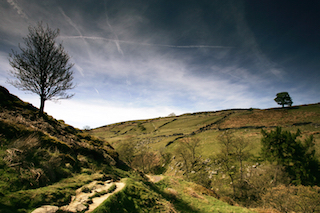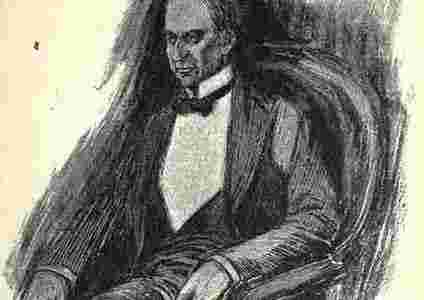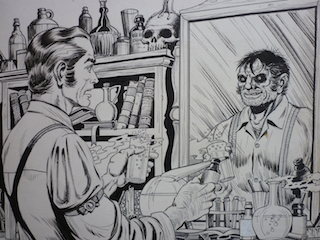Stevenson and Bronte: The Similarity Between Vastly Different Stories
Emily Bronte’s Wuthering Heights and Robert Louis Stevenson’s The Strange Case of Dr. Jekyll and Mr. Hyde have similarities in their narrative setting, characterization and also gothic elements. Wuthering Heights is set in a murky countryside, with a distasteful and hateful protagonist. Similarly, in The Strange Case, Stevenson uses the setting and his twisted protagonist to add to the gothic undertone of his story. His story is set in a shadowed London, with a twisted and repulsive main character. Ultimately, these differences and similarities lead to the important elements of the gothic in both the texts.
The Darkness of the Setting

Though the novels are set in entirely different places, one in the city and one in the country, the aura of the respective places is similar. Wuthering Heights’ plot is based mostly in the murky, muggy land of the moors. One of the characters accurately notes the desolation of the moors: “the whole extent of landscape besides lay in shadow. I explained that they were bare masses of stone, with hardly enough earth in their clefts to nourish a stunted tree” (168).
These moors play an important descriptive role in the novel, and add elements of darkness to the story. Furthermore, the moors are supposedly a breeding ground for ghosts and other supernatural elements, thereby adding a layer of the gothic to the novel.
On the other hand, The Strange Case of Dr. Jekyll and Mr. Hyde is set in a misty and foggy London, with dark alleyways and undetectable corners. The narrator likens the districts of London to gothic images: “The dismal quarters of Soho […] with its muddy ways, and slatternly patterns […] like a district in some city in a nightmare” (22). The narrator also states how the “the fog still slept on the wing above the drowned city, where the lams glimmered like carbuncles” (26). Most of the scenes take place in the nighttime, and the occurrences take place with the moon as the witness: “It was a wild, cold seasonable night of March, with a pale moon” (34).
The nightmarish streets, fog and darkness together form an aura of shadow over the entire story, thereby creating a veil and shrouded element in the novel. Both the novels endorse these dark and shrouded landscapes, indulging in the gothic element of darkness and mystery.
Outer Vs Inner Self
Both Bronte and Stevenson also have equally interesting and twisted main characters; Heathcliff and Dr. Jekyll present certain similarities in their behaviors that are manifested and represented in different ways. Heathcliff is depicted as a dark, black personality, both in appearances and in behavior.
More than once, other characters view Heathcliff as a terrifying and horrifying character, highlighting his inhuman outer personality: “the same unnatural-it was unnatural-appearance of joy under his black brow; the same bloodless hue, and his teeth visible […] his frame shivering […] a strong thrilling, rather than trembling” (292). He rarely ever portrays himself in a manner that redeems this depiction. However, every so often, the readers are allowed a glimpse of his inner self. At one point, he burst into an “uncontrollable passion of tears” and called for his love, sobbing, “Oh! My heart’s darling hear me this time””(24).
His love for Catherine, and his heartbreak over her marriage and death are both indicators of his vulnerability. Notably, Heathcliff does everything in his power to hide this inner-self from others, and even from himself. He prefers to remain hateful and hated.

Whereas, Heathcliff’s outer self is crass and inner self is soft, Dr. Jekyll’s situation is the opposite. His intelligent and likable ‘outer’ personality opposes his violent and horrifying ‘inner’ personality. On the outside, Dr Jekyll appears as “a large, well-made, smooth-faced man of fifty, with something of a slyish cast perhaps, but every mark of capacity and kindness” and even has the capability of displaying “a sincere and warm affection” (18).
His inner-self, or other side, behaves violently and animal-like and displays inhuman qualities: “Mr Hyde shrank back with a hissing intake of the breath […] (he) snarled aloud into a savage laugh” (7-8). Dr. Jekyll recognizes the discrepancy in his self-perception, and actively takes steps to undo the two and bring out the inner-self. Like Heathcliff, Dr. Jekyll prefers his violent and hateful part of the self to his softer and warmer counterpart. The main difference between the two character remains that one has to hide his good inner-self and maintain his bad aura, whereas the other has to suppress his good outer-self in order to bring out the horrible inner-self.

Dr Jekyll looking at the mirror and seeing his inner personality, Mr Hyde
Connecting the Gothic Elements
Both these elements highlight the importance of the gothic in literature. The setting and character depiction usually adds to the gothic undertones of the novel. In these cases as well, The Strange Cases’ misty London setting and Wuthering Heights’ moorish land give a good placement for the gothic.
Furthermore, characters in the novel repeatedly draw attention to Heathcliff’s dark skin and heritage, which is supposedly foreign. His blackness is contrasted with whiteness to highlight his appearance and personality: “his black countenance looked blightingly through […] his hair and clothes were whitened with snow and his sharp cannibal teeth, revealed by cold and wrath, gleamed in the dark” (156). Heathcliff is considered a gypsy, and the combination of unknown origin and dark skin is essential in a gothic novel like Zofloya. Whereas Dr. Jekyll’s character does not have a racial element, his Mr. Hyde does have a despicable appearance. The narrator observes: “Mr Hyde was pale and dwarfish, gave an impression of deformity without any nameable malformation, he had a displeasing smile […] a sort of murderous mixture of timidity and boldness, and he spoke with a husky, whispering and somewhat broken voice” (8).
His physical appearance is enough to add to the gothic, all twisted and disfigured. It consistently horrifies and terrifies characters that witness his appearance; these are important feelings usually invoked in the gothic. Furthermore, the character’s physical appearances further endorse fear as they are compared to Satanic and supernatural creatures. In this way, Heathcliff indirectly invokes the gothic terror in other characters, whereas Mr Hyde is in every way himself a symbol of gothic horror and terror.
Both authors use dark features and themes to highlight plot elements in their novels, thereby adding supernatural and gothic elements to their stories. Through the use of various elements, including settings and characterization, the authors both enhance the darkness of their respective novels. Bronte paints a portrait of a weary landscape and a tortured soul, whereas Stevenson creates a structure of a dreary city and a disabled human.
Ultimately, through these important narrative elements and plot developments, both stories endorse the darkness and twisted nature of the gothic structure.
Works Cited
Bronte, Emily. Wuthering Heights. Ed Ian Jack and Helen Small. New York: Oxford University Press Inc., 2009. Print.
Stevenson, Robert Louis. The Strange Case of Dr Jekyll and Mr Hyde. Ed. Roger Luckhurst. New York: Oxford University Press Inc., 2008. Print.
What do you think? Leave a comment.











Very nice compare and contrast on the luminous and darkness of the characters exterior and interior personas, alongside the comparison and contrast of the terrain. Nice read.
Thanks !
There are so much symbolism and different interpretations of these work. You did a great job putting them together like this.
Thanks !
Stevenson summed up the emotions, error, and thinking of the human mind so perfectly with his novel.
Thanks for reading
All I’m going to say is that after reading W Heights, it made me glad that my life is not like that.
Thanks for the read
Very well written- the comparison is well done. Excellent work
Thanks !!
Awesome job comparing two works with distinct Gothic elements. I like how you mentioned the theme of how othered characters are treated in such pieces.
Thanks !
I have to say that I disagree with parts of this. I’m not sure that Dr. Jekyll truly wanted to become Mr. Hyde; he enjoys it at first, yes, but then he tries to destroy that inner self entirely. He fails, but he does try. If anything, Mr. Hyde wins and takes over against Dr. Jekyll’s will. In that sense, while I see some interesting parallels with the character of Heathcliff, I have to disagree with the idea that he wants his darker inner self to win. If anything, I think that both works focus on tortured souls, with one just being more blatant about duality through a physical transformation.
However, I do think that you pointed out several elements that do pinpoint why these works are such excellent examples of the gothic genre.
Thanks for your insight! And for the read as well 🙂
I have never really thought of these two stories as similar. Nice comparison.
Thank you
Excellent analysis . Very well written.
Awww thank you for reading !
I’ll admit it – I’ve deliberately avoided reading The Strange Case of Dr Jekyll and Mr Hyde for years. I suppose it’s entered folk-lore and spreads through thoughts and cultures still. It’s revered by many and I was a little concerned that I’d be disappointed by the book. What a fool I’ve been. Going to pick up Wuthering Heights next!
I do recommend it. Thanks for the read !
Oh Heathcliff… the original ‘jerk that I love’!!
Ahhh, if only I loved him. Thanks for the read
There are the books that fit right into your comfort zone. Like a childhood friend or cousin… The reason why I liked Wuthering Heights so much was NOT because it fit right within my reading comfort zone. In fact, it did the exact opposite. Thank you for writing about it.
Thank YOU for reading it !
Thank you for reading
These are timeless and brilliant books!
I agree !
I first came across Wuthering Heights aged fourteen, when we examined the first three chapters for gothic elements in English class. I will certainly place Dr. Jekyll and Mr. Hyde on my reading list.
Definitely do 🙂
Heights represents the pinnacle of tragic storytelling really.
Agreed !
I was surprised at how short Dr J & Mr Hyde was.
But lovely !
Stevenson’s presentation of man’s sin makes us acutely aware of our need for the gospel.
Thanks for the read
Wuthering Heights and Dr. Jekyll and Mr. Hyde are novels that people love or hate. I love them both. Great analysis.
Thank you so much !
Wuthering Heights is a modern myth.
Good insight !
Both of these books handle the fight with one’s inner self and tortured self very well, but I do think Heathcliff finds being an incorrigible jerk more pleasing to himself than Dr. Jekyll as he gets replaced by Mr. Hyde. Both tortured souls are treated differently, but other than that, the comparison was very well written.
Thank you !
To be quite honest, I could barely stomach any of these books back then when I read them first. It was too strange, wild, and terrifying to me. The second time I read them, several years ago, I was much older. Thus, I was able to appreciate their masterfulness.
Was this article meant for people with some familiarity with Gothic elements, or people with none? I’m not very familiar with what Gothic pieces usually involve — I would’ve liked a small overview of this, to help me fit these two pieces into that framework.
On a different note, I like your comparison between Heathcliff and Jekyll’s inner vs. outer selves — how the one has a mean shell hiding a nice side, while the other has a nice shell hiding a dark side. Very cool connection!
Thank you for this article, I loved it! I am looking forward to reading more from you. 🙂 Keep up the amazing work.
These are gothic dreams that lingers to haunt you for a long-long time.
I would say that i find it hard to agree with the content-based comparison. The two authors wrote in different literary eras. Bronte was a Romantic, and Stevenson was of the Enlightenment. Despite the fact that Stevenson was a bit of an outlier of the Enlightenment, he still had the emphasis on reason over passions in his literature (Romanticism emphasises emotion over reason).
They’re compared for the same reasons we compare to Macbeth to Frankenstein. The value of literature in comparison comes not from restrictions of chronology, genre or form, but identifiable and textual connections and influences between works. Bronte and Stevenson were certainly different writers, but they were both major contributors to the body of Gothic literature as we consider it today. If they are in any way at odds with each other, that additional issue is also worth exploring through comparison – the Romantic Gothic versus the Enlightened Gothic.
It would be nice to see this essay (essentially descriptive and internally analytical) move beyond the limits of the texts and connect with the outside society.
Start with Terry Eagleton’s “Heathcliff and the Great Hunger” (Verso Books, 1996) …
It’s really interesting to see how two completely different texts might actually have a lot in common!